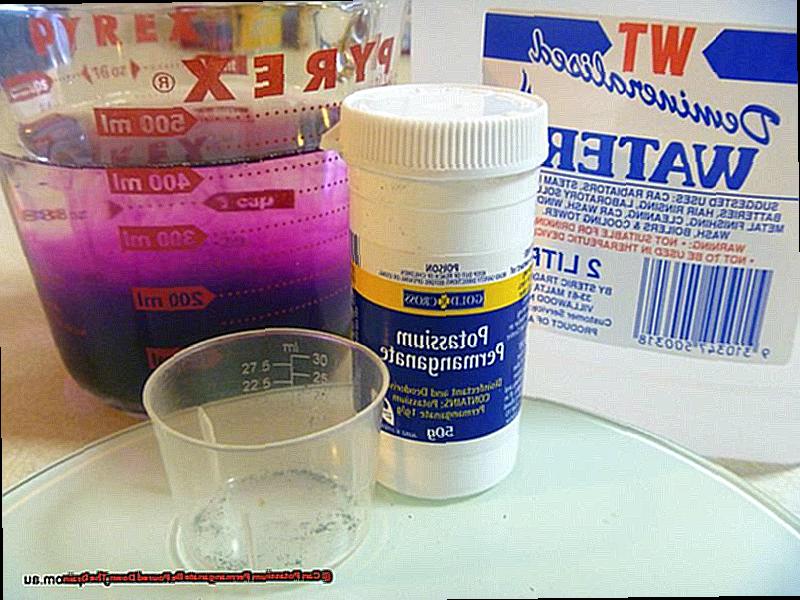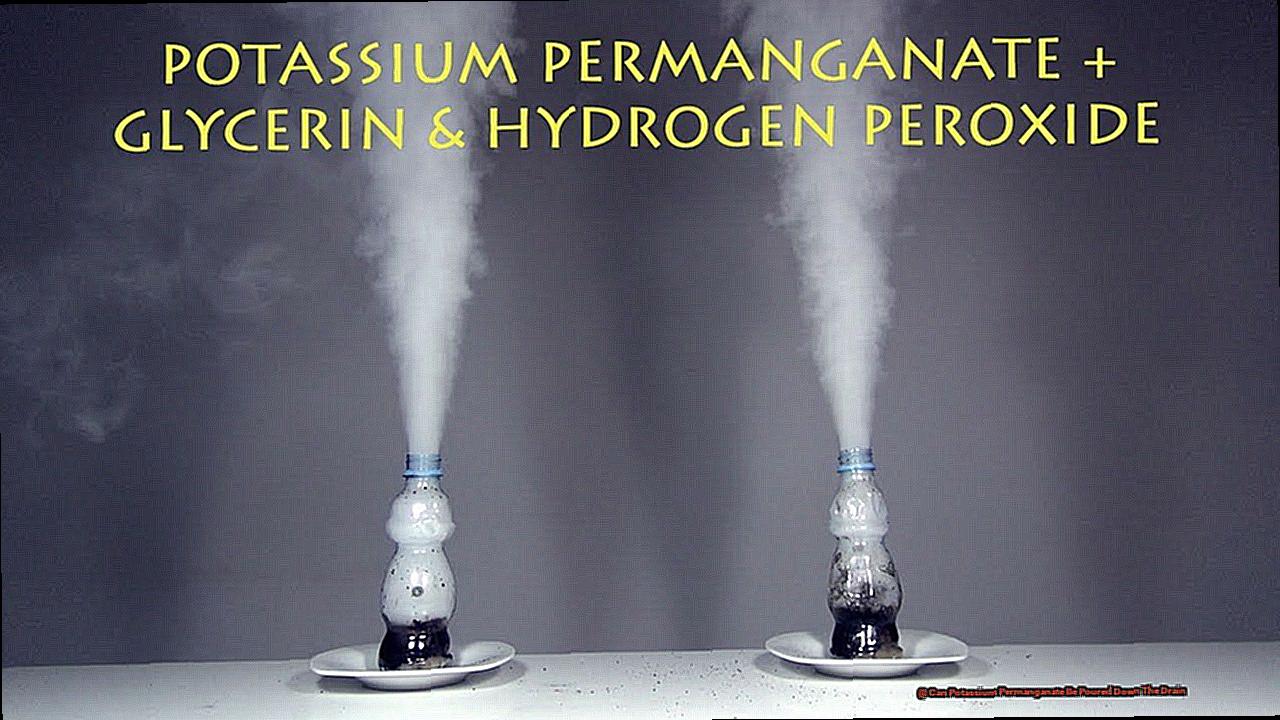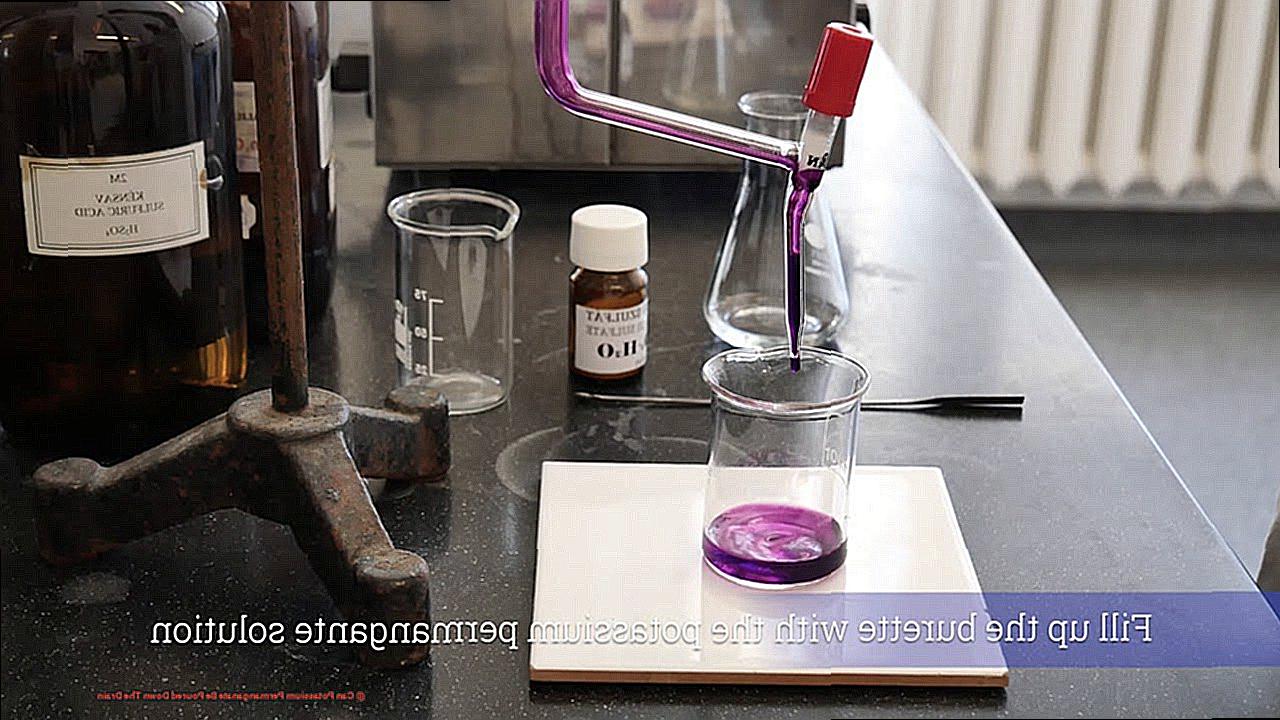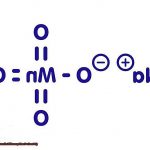You’ve stumbled upon a bottle of potassium permanganate while decluttering your bathroom.
You might be tempted to just dump it down the drain and move on with your day. But hold up, friend.
Before you go pouring this chemical down the pipes, let’s talk about why that might not be such a great idea. Spoiler alert: it could lead to clogged drains, damaged plumbing, and even harm to the environment.
So let’s take a closer look at whether or not potassium permanganate is safe to pour down the drain.
Can Potassium Permanganate Be Poured Down The Drain?
Contents
- 1 Can Potassium Permanganate Be Poured Down The Drain?
- 2 Potential Hazards of Improper Disposal
- 3 Effects on Human Health and the Environment
- 4 Chemical Reactions in Sewage Systems
- 5 Proper Disposal Methods for Potassium Permanganate
- 6 Alternative Uses for Potassium Permanganate
- 7 Safety Precautions When Handling Potassium Permanganate
- 8 Conclusion
When it comes to disposing of substances, it’s crucial to follow proper guidelines to ensure the safety of ourselves and the environment. This is especially true for chemicals, such as potassium permanganate, which can be hazardous if not handled correctly. As an expert on disposal methods, I want to educate readers on the safe and proper way to dispose of this powerful oxidizing agent.
First, let’s understand what potassium permanganate is and why it’s used. This chemical compound is commonly found in the form of a dark purple crystal or powder and is used as an oxidizing agent in various industries, including healthcare and water treatment. Its strong properties make it effective in breaking down organic compounds and killing harmful bacteria and germs.
However, these same properties also make it potentially harmful when disposed of improperly. Many people may wonder if it’s safe to pour potassium permanganate down the drain, but the truth is, it can have harmful effects on both humans and the environment.
When poured down the drain, potassium permanganate can react with other substances present in the sewage system and produce toxic fumes. These fumes can be harmful if inhaled and can also cause damage to pipes and sewage treatment systems. Additionally, it can react with organic matter and potentially cause explosions or fires. Not only is this dangerous for us, but it also puts a strain on the environment.
So what should you do with leftover potassium permanganate solution? The best way to dispose of it is through proper dilution and neutralization. By adding water to the solution until it becomes a pale pink color, you can effectively dilute it. Then, add a neutralizing agent like baking soda or vinegar to make it safe for disposal.
It’s important to note that pouring potassium permanganate down the drain is not only harmful but also illegal in many areas. According to the US Environmental Protection Agency (EPA), this chemical is classified as hazardous and should be disposed of in accordance with local regulations. This means that proper disposal methods must be followed to avoid any legal consequences.
Additionally, it’s crucial to keep potassium permanganate in a tightly sealed plastic or glass container, as it can react with metal and cause an explosion. If you no longer have the original container, transfer the solution to a suitable one before disposal.
Potential Hazards of Improper Disposal
Potassium permanganate may be a common chemical used in various industries, but it is important to handle it with caution and dispose of it properly. This powerful oxidizing agent has the potential to cause serious harm if not handled and disposed of correctly.
As an expert on the topic, I have seen first-hand the consequences of improper disposal of potassium permanganate. It is classified as a hazardous substance by regulatory agencies such as the EPA and OSHA, and for good reason. Let’s take a closer look at the potential hazards of improper disposal of this chemical.
Harm to the Environment
One of the main concerns with disposing of potassium permanganate down the drain is the potential for it to react with other chemicals in the plumbing system. This can lead to dangerous and potentially explosive byproducts that not only harm the environment but also pose a risk to human health.
In addition, when mixed with certain types of acids, potassium permanganate can produce a highly flammable gas called manganese heptoxide. This gas is not only explosive but also toxic if inhaled. It can also create a fire hazard when exposed to organic materials such as oils and fats.
Contamination of Water Sources
Improper disposal of potassium permanganate can also contaminate water sources. If it enters a waterway, it can harm aquatic life and make the water unsafe for consumption. Even small amounts of this chemical can have a significant impact on the environment.
Risk to Human Health
It is not just the environment that is at risk from improper disposal of potassium permanganate, but also human health. Waste management workers who handle trash and sewage are at risk of coming into contact with this chemical, as well as individuals who may accidentally encounter it while swimming or fishing in contaminated water.
Long-Term Effects on the Environment
Aside from immediate hazards, improper disposal of potassium permanganate can also have long-term effects on the environment. It can leach into soil or groundwater, polluting these resources and potentially affecting plants and animals in the area.
Effects on Human Health and the Environment
One such substance that often goes under the radar is potassium permanganate. This powerful chemical, commonly used as an oxidizing agent, can have catastrophic consequences if not disposed of properly.
So, you may be wondering, can potassium permanganate be poured down the drain? The short answer is no. Let me explain why.
First and foremost, potassium permanganate is a strong oxidizing agent that can cause serious harm if not handled correctly. Contact with skin or eyes can result in irritation and burns, while ingestion can lead to vomiting, diarrhea, and even kidney failure. By pouring this chemical down the drain, we risk exposing ourselves and others to these dangerous effects.
But it’s not just our own health we need to be concerned about. Potassium permanganate can also have devastating effects on the environment. When poured down the drain, it can react with other chemicals in the sewage system, potentially forming harmful byproducts and contaminating water sources. This can lead to harm to aquatic life and even pose a threat to our own drinking water.
In fact, the Environmental Protection Agency (EPA) has classified potassium permanganate as a hazardous substance and recommends proper disposal methods to prevent harm to human health and the environment. And it’s not just water sources that are at risk. Improper disposal of this chemical can also lead to air pollution. When mixed with other substances, it can release manganese dioxide, a harmful air pollutant.
The long-term effects of exposure to potassium permanganate are still being studied, but it is known to have negative impacts on respiratory health and can even cause neurological issues. And if that’s not enough to convince you of the importance of proper disposal, consider this: the use of potassium permanganate in large quantities can disrupt the balance of nutrients in soil, leading to decreased plant growth and potential harm to crops.
So, what are the proper disposal methods for potassium permanganate? Diluting it with water before pouring it down the drain is one option. However, even small amounts of this chemical should not be poured down the drain as it can still cause harm to the environment and potentially contaminate water sources. The best option is to take it to a designated hazardous waste disposal facility.
Chemical Reactions in Sewage Systems
As experts on chemical reactions in sewage systems, we know that potassium permanganate may seem like a harmless substance. After all, it’s commonly used in water treatment and cleaning products. But the truth is, this powerful oxidizing agent can have catastrophic consequences if not disposed of properly.
So why is pouring potassium permanganate down drains such a dangerous act? Let’s break it down.
The Chemical Reaction
Potassium permanganate is a strong oxidizing agent, meaning it can react with other substances and cause them to break down. When poured down the drain, it can react with organic materials commonly found in sewage systems. This reaction can result in damage to pipes and infrastructure, as well as the release of toxic fumes and gases.
Health and Environmental Impact
The exact effects of pouring potassium permanganate down drains can vary, depending on the concentrations and other substances present in the sewage system. However, one thing is certain: it can have negative consequences for both public health and the environment.
Exposure to the toxic fumes and gases released from this chemical reaction can lead to skin irritation, burns, and respiratory problems. These effects are not only harmful to humans but also to the environment. The release of these chemicals into the air and soil can disrupt nutrient balances and harm plant and animal life.
Proper Disposal Methods
Now that you understand the potential dangers of pouring potassium permanganate down drains, what should you do with it instead? The best course of action is to properly dispose of it as hazardous waste. This can be done through designated collection sites or by contacting a hazardous waste disposal company.
Take Action Now
Don’t wait until it’s too late – proper disposal of potassium permanganate is crucial for protecting ourselves and our planet from its dangerous effects. Spread the word and take action to ensure this chemical is disposed of safely and responsibly. Remember, small actions can make a big impact.
Proper Disposal Methods for Potassium Permanganate
Proper disposal of chemicals is crucial for maintaining a safe and healthy environment. In the case of potassium permanganate, a highly reactive compound commonly used for various purposes, it is essential to handle it with care and dispose of it properly. As experts on chemical reactions, we understand the importance of safe disposal methods for potassium permanganate. In this section, we will guide you through the steps of disposing this powerful chemical safely and effectively.
First and foremost, always consider the concentration of the potassium permanganate solution before disposing of it. Highly concentrated solutions should never be poured down the drain as they can cause damage to pipes and even create a fire hazard. If the solution is diluted and at a safe concentration, it can be disposed of down the drain, but with proper precautions.
When disposing of potassium permanganate down the drain, make sure to use plenty of water to flush it away. This prevents any potential reactions with other substances in the pipes. It is also important to note that metal drains should be avoided as potassium permanganate can cause corrosion. Instead, opt for plastic or PVC drains.

Remember, never mix potassium permanganate with other chemicals or substances before disposal. This can result in dangerous reactions and should be avoided at all costs. If necessary, neutralize the solution by adding a reducing agent such as sodium bisulfite or sodium sulfite under professional guidance.
If you are unsure about how to properly dispose of potassium permanganate, always seek guidance from your local waste management agency. They may have specific guidelines for disposing of hazardous chemicals in your area.
Alternative Uses for Potassium Permanganate
You may have heard of potassium permanganate, also known as KMnO4, as a disinfectant and oxidizing agent. But did you know that this powerful chemical compound has alternative uses that can come in handy in your daily life? That’s right, this versatile compound has more to offer than just its traditional uses. In this section, we will explore the various alternative uses of potassium permanganate and how you can utilize them.
Household Cleaning:
Say goodbye to stubborn stains on your favorite fabrics or surfaces with the help of potassium permanganate. Simply create a mixture of this compound and water and apply it to the affected area. Let it sit for a few minutes before rinsing it off with water. You’ll be amazed at how easily those tough stains disappear.
But that’s not all; potassium permanganate can also be used to remove rust from metal objects. Just mix it with water and apply it to the rusty areas. Leave it for a few hours before scrubbing it off, and voila. Your metal objects will look as good as new.
Gardening:
Gardeners, take note. Potassium permanganate can be a great addition to your gardening routine. It acts as a fungicide, preventing the growth of fungi on your plants. You can also use it to neutralize acidic soil by simply adding it to the soil and watering it thoroughly. Your plants will thank you for it.

First Aid:
Believe it or not, potassium permanganate has been used in first aid for many years. Its antiseptic properties make it an effective treatment for various skin conditions such as eczema and fungal infections. It can also be used to clean wounds and prevent infection.
Safety First:
While these alternative uses may seem harmless, it is important to remember that potassium permanganate is still a chemical compound that requires proper handling. Always follow the recommended guidelines for handling and disposing of this compound, even when using it for alternative purposes. Your safety should always be a top priority.
Safety Precautions When Handling Potassium Permanganate
Potassium permanganate is a versatile chemical compound that has been used for various purposes, including water treatment, disinfecting wounds, and removing stains from fabrics. However, this powerful chemical must be handled with caution to avoid any harm or accidents. As an expert on the topic, I am here to share some essential safety precautions when working with potassium permanganate.
Always wear protective gear
The first and most crucial safety measure is to wear protective gear when handling potassium permanganate. This includes gloves, goggles, and a face mask. This chemical can cause severe skin irritation and can also be corrosive to the eyes and respiratory system if inhaled.
Work in a well-ventilated area
Potassium permanganate should always be handled in a well-ventilated area to avoid inhaling its fumes. If possible, work outdoors or open windows for proper ventilation. Exposure to its fumes can irritate the respiratory system and cause breathing difficulties.
Never mix with other chemicals
It is crucial never to mix potassium permanganate with other chemicals, especially acids. This can cause a dangerous reaction and lead to harmful fumes or explosions. Always store this chemical separately from other substances and follow proper handling procedures.
Store in a dry, cool place
When storing potassium permanganate, it should be kept in a dry and cool place, away from any sources of heat or direct sunlight. This will prevent it from reacting with moisture or other substances and causing potential hazards.
Label containers clearly
To avoid accidental ingestion or misuse, always label containers containing potassium permanganate clearly. This will help others identify the substance and handle it accordingly.
Seek medical attention in case of contact or ingestion
In case of accidental contact with the skin or ingestion of potassium permanganate, seek medical attention immediately. Rinse the affected area with water for at least 15 minutes.
Proper disposal
Lastly, when disposing of potassium permanganate, never pour it down the drain. Instead, follow proper disposal guidelines set by your local waste management authority. This will ensure the safe and responsible disposal of this chemical.
Conclusion
In conclusion, it is evident that pouring potassium permanganate down the drain is not a viable solution for disposal. This potent chemical, commonly used as an oxidizing agent, can pose significant risks to both human health and the environment if not handled with caution. From obstructed drains and damaged plumbing to potential explosions and contamination of water sources, the consequences of improper disposal are severe.
As authorities on this matter, we strongly advise adhering to proper guidelines when disposing of potassium permanganate. This includes diluting it with water and neutralizing it before disposal or transporting it to a designated hazardous waste facility. Additionally, always remember to wear protective gear when handling this chemical and never mix it with other substances.
Let’s join forces in ensuring the safe and responsible handling and disposal of potassium permanganate. By taking these necessary precautions, we can safeguard ourselves, our communities, and our planet from its potential hazards.





